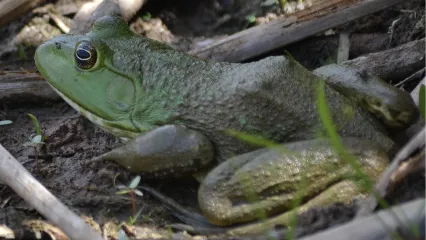
Description
The red-spotted toad is a small, flat toad with gray or greenish-gray skin and a pointed snout. The cranial crests are indistinct or absent. Its name refers to tiny red spots scattered on its back and legs or within darker brown spots on the back and legs. The parotoid glands (shoulder glands) are small and round. The undersides are grayish white with or without small gray spots. Juveniles have more spotting on the undersides than adults. The palms of the hands and soles of the feet are light orange to yellow. The lower half of the belly is gray and forms a pelvic patch, which is more permeable to water than the skin on the back and legs, allowing the toad to take in water by sitting on damp soil. Males have dark throats and females have white throats. These toads move about by walking instead of hopping.
The small tadpoles are mostly black, but they become blotched with black and white as they become larger. The eyes are located on top of the head, and the undersides are black with gold or silver spotting. The tail fins are nearly transparent with fine dark streaks. The call of the red-spotted toad is a high-pitched musical trill. They can be heard throughout most of the summer after rains.
The calls can sometimes be confused with those of crickets or other insects.
Size
Red-spotted toads are small, attaining a body length to about 3 inches. Females are larger than males.
Habitat
Red-spotted toads occur throughout the southwestern United States, from parts of southern California to the Central Plains. In Oklahoma, red-spotted toads inhabit grasslands, oak woodlands, and floodplains along rivers or streams. They prefer rocky areas.
Life Cycle
These toads breed primarily in summer months after rainfall. Males call from the edges of quiet rain pools or pools in floodplains. Most toads lay their eggs in strings, but the red-spotted toad lays its eggs singly. The small eggs may adhere to each other and form small clusters on the bottom of pools. Tadpoles require six to eight weeks to transform into toadlets.
Red-spotted toads feed on small insects, including ants.
How To Observe
These toads are not commonly seen; they do not forage around houses or beneath street lights in towns. They can be found at night by following the sound of their calls or by carefully searching on roads when the humidity is high or it is raining. During the day, particularly in early fall, they can be found beneath rocks or other cover objects.
(This profile was created by Dr. Laurie Vitt as part of a partnership between the Wildlife Department and the Sam Noble Oklahoma Museum of Natural History. It was funded as part of a larger grant to survey and inventory amphibians and reptiles of the Wildlife Management Areas of Oklahoma: T-35-P-1.)


